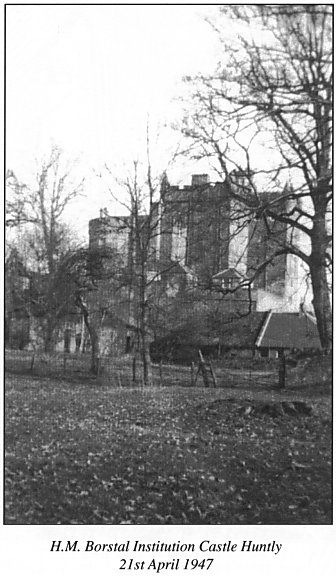The oldest part of the
building dates from the 15th century and comprises of a traditional tower
and jamb design, having no accessible windows on the ground floor and only
one door. This style is common to much of the fortified Scottish
architecture of the mid 15th century and earlier part of the 16th.
century. Throughout its five hundred year history considerable alterations
have been made, but much of the original structure has remained intact to
this day. The most notable development work was carried out in the 17th
and 18th centuries and later in the 1940s when the house passed into
public ownership. However, the building has been in an almost constant
state of evolution throughout its history.
The thick red Kingoodie
sandstone walls are so well integrated with the naked rock of its
foundations, that it is difficult to ascertain at what level the rock
outcrop ends and masonry begins. First impressions are that the rock was
hewn out to provide a platform on which the castle was built, but in
reality it is only the Georgian wings which are so. From the south-west it
can be seen that the castle was built up the face of the cliff, with the
lower apartments being formed in the natural irregularities of the rock
strata.
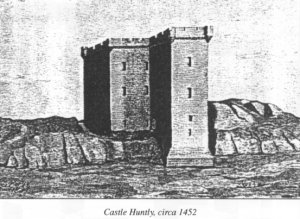 The
original keep would have been entered by a door several feet above the
rock foundation. At some time an apron wall was built over the south-west
rock face, up to the level of the entrance to the keep, behind which a
series of cellars with 3 foot thick walls and vaulted ceilings were
constructed.
The
original keep would have been entered by a door several feet above the
rock foundation. At some time an apron wall was built over the south-west
rock face, up to the level of the entrance to the keep, behind which a
series of cellars with 3 foot thick walls and vaulted ceilings were
constructed.
Vaulting was common
building practice and was an incredibly strong method of roof
construction, since the entire ceiling was under compressive loading. The
immediate benefit was that the stonework could be handled manually and did
not require to be fine cut. Additionally upper floors could be supported
on the vaulting without the need for any reinforcing stonework or long
spans of timber joisting.
In Castle Huntly a roof was
laid on top of the cellars, which formed a courtyard at the North West
entrance. Entrance to the cellars was down a spiral staircase or by a
doorway in the apron wall. The floors of the cellars are of rough rock and
would have been the original level of approach to the doorway some 12 feet
above these floors. Although the courtyard provided easier access to the
castle there was still no access from the cellars other than the single
door in the re-entrant. This development would have probably taken place
as the need for a defensive structure diminished, but it is interesting to
note that some caution was still displayed, by the maintenance of a single
entrance which was not subject to development in any way.
There appears to have been
three main floors above the rock foundations, with a pit or prison formed
out of the solid rock below, but during the 17th century alterations, an
extra floor was inserted.
The pit was a fearsome
place, built over a natural void in the rock, it measured 12 feet by 17
feet with a 15 foot high ceiling and earth floor. The only light and
ventilation was provided by a tiny slit or loop window high on the
south-west wall. The pit or dungeon could be entered only by a trap-door
in the floor of the guardroom above.
The guardroom, entered through
a fine pointed doorway, in the re-entrant or jamb was the original and
only entrance of the castle. While the height of the ceilings in the main
cellars are only 12 feet, the guard room is 20 feet. This was for security
reasons. An arched passage was left in high up in the vaulting through the
rear wall of the guard room, at the level of the first floor, with three
steps leading down and stopping abruptly at the outer edge. From this
platform a ladder could be withdrawn, safely isolating the living
accommodation from the ground floor.
The main block at ground
level consisted of three barrel-vaulted cellars, 42 feet by 18 feet part
cut into the living rock. A well, now filled in, was sunk in the floor of
the middle cellar. The walls, as they emerge from the rock strata, are in
general about 10 feet thick in this area and the windows consist of only
narrow slits. In consequence there is little seasonal temperature
variation. This made them ideal for the storage of wine, one of which
still has the stone racks in place.
The oldest parts of the
castle walls are fonned of an outer layer of dressed stones laid on the
same plane from which they were quarried and an inner wall which was only
roughly dressed. Into the cavity was placed whin and boulders of different
size to form rubble. A thin mortar of grouted lime and sand marl was then
poured into the rubble forming a dense, impervious concrete.
After 1660, the Earl of
Strathmore, when making his improvements, built up the original doorway to
the guardroom, and as stated in The Book of Records, he opened a new
doorway in the north-east side of the castle. Although there is no
north-east wall which leads from ground level up to this first floor.
Above the doorway there is some indication, now bricked up, of what may
have been a window. When alterations were being made in 1778 the original
first floor was reduced to the status of a service area, now known as the
Mezzanine Landing, and the stairway hidden behind the north-west end of
the Oval Room. Also during the 1778 renovations, the original 15th century
doorway was reopened and the original iron yett was found in position.
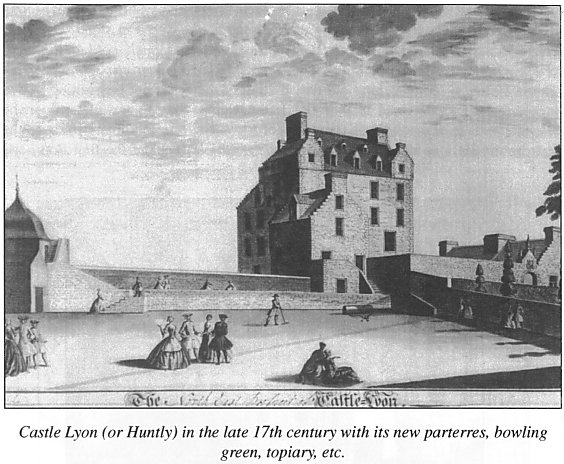
As previously indicated,
access to the main living floors above the guardroom, although
inconvenient was secure. There was no pennanent internal stair at this
level only a passage high in the springing of the guardroom vault which
would be reached by a removable ladder which could be pulled up. This
seems to have been the only approach to the living quarters, and as late
as 1946 only a light wooden stairway was in use. Today the guardroom is
split by a ceiling, with the upper floor under redevelopment as office
accommodation.
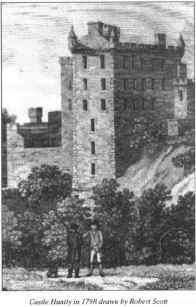 The
hall on the first floor measured 43 feet by 19 feet with a high barrel
vaulted ceiling and a fireplace at the north-west end. A circular stair
cut in the solid wall at the re-entrant led to the upper floor and the
roof. This vault was removed by the third Earl of Kinghorne in the 17th
century and an extra timber floor inserted.
The
hall on the first floor measured 43 feet by 19 feet with a high barrel
vaulted ceiling and a fireplace at the north-west end. A circular stair
cut in the solid wall at the re-entrant led to the upper floor and the
roof. This vault was removed by the third Earl of Kinghorne in the 17th
century and an extra timber floor inserted.
The second floor replicated
the first, with the addition of a chamber over the guard room, and from
the writings of the Earl it can be concluded that before the alterations,
there were no guardrobes or wall chambers provided.
The original castle
comprised of only three floors, the vaulting of the second floor
projecting above the parapet walls with the roof covered in stone flags.
Earl Patrick States in his book of records. "The house was extremely
cold and the hall was a vault out of which by the striking thereof
I have gained the rooms above." This work consisted of cutting
out the vaulting of the first floor and setting in two joisted floors and
so gained an extra flat. In the walls of the two new upper floors he cut
chambers in the solid walls and reduced two walls in the chambers over the
guardroom. He also skinned 4 feet from the north-east wall of the first
floor, and when alterations were being made in 1778 it was found that the
full thickness of the floor above the hall was overhanging and was carried
on the joists of the new floor.
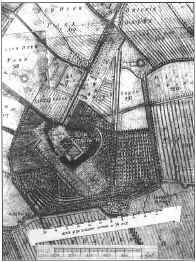 The
top storey of this lofty tower was altogether altered in appearance in
1776 by George Paterson when the entire castle was re-roofed. A central
round tower or lantern was added raising the height of the castle to 116
feet above the level of the Carse and capping the bartisans or turrets. In
addition, two Georgian wings on the north-east elevation were added; each
of two stories and an oval entrance hall topped by a cast oval glazed
cupola. When first constructed the central entrance hail projected much
further out from the line of the building and was supported by two
roundals on either corner. These have since been removed and the walling
set further back.
The
top storey of this lofty tower was altogether altered in appearance in
1776 by George Paterson when the entire castle was re-roofed. A central
round tower or lantern was added raising the height of the castle to 116
feet above the level of the Carse and capping the bartisans or turrets. In
addition, two Georgian wings on the north-east elevation were added; each
of two stories and an oval entrance hall topped by a cast oval glazed
cupola. When first constructed the central entrance hail projected much
further out from the line of the building and was supported by two
roundals on either corner. These have since been removed and the walling
set further back.
In 1780 when sinking foundations for
some additional buildings a deep ditch was unearthed which appeared to be
filled with wood ashes and other waste materials. The absence of any coal
ash indicated the site to be of great antiquity. In the Book of Glamis
there is mention of a moat round the building — There
was a bridge with a pend over a mighty broad and deep ditch which
surrounded the house upon the inner brink whereof there was a high wall, a
gate fornet the bridge and over the gate a little lodge for the porter.
In 1996 when excavating
post holes on the south-east lawn, the subsoil appeared to be made up
ground and comprised almost entirely of small whin boulders and broken
sandstone.
